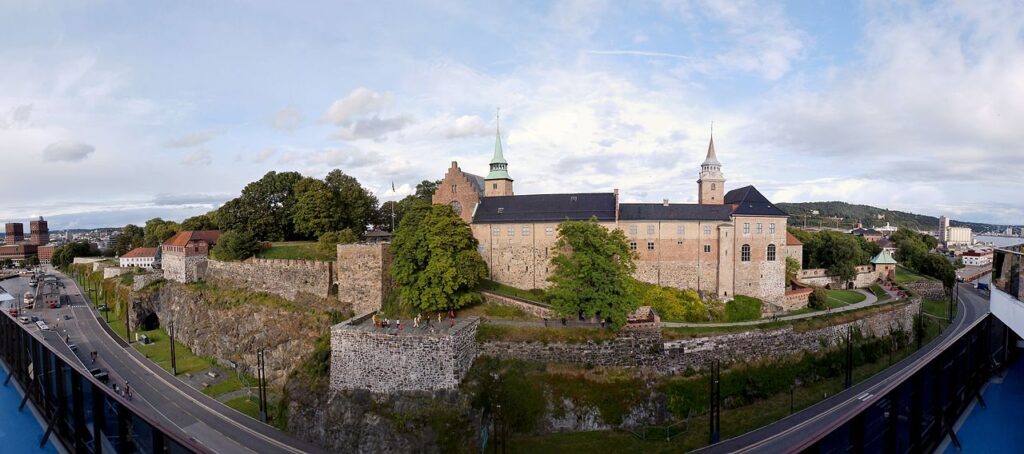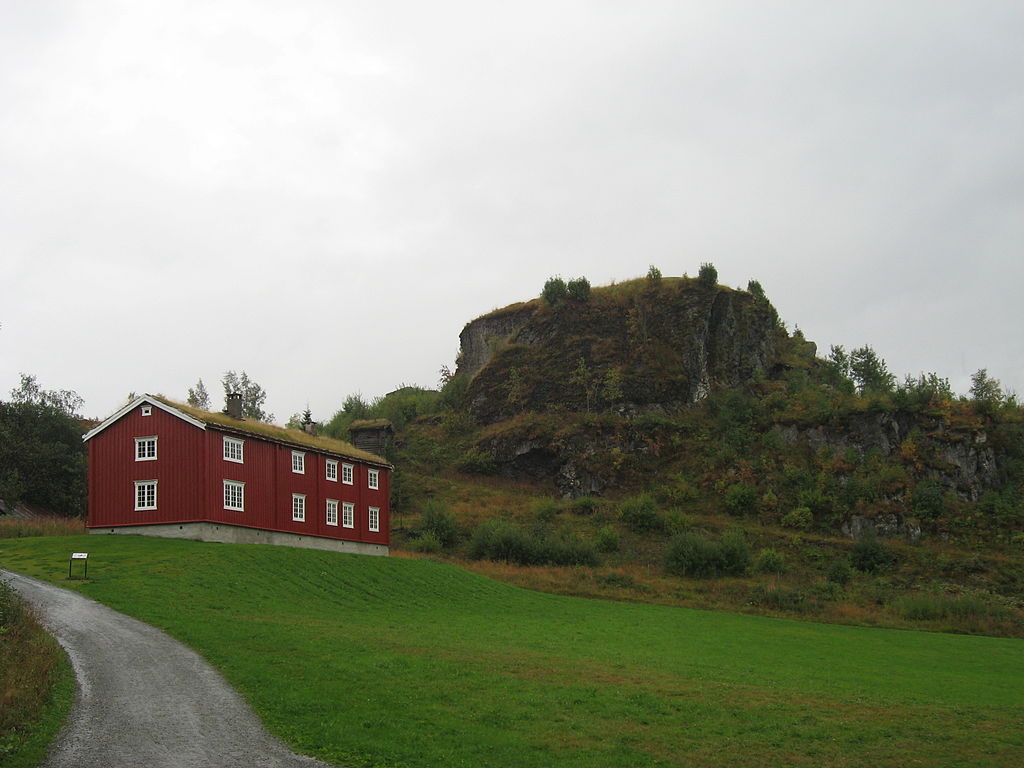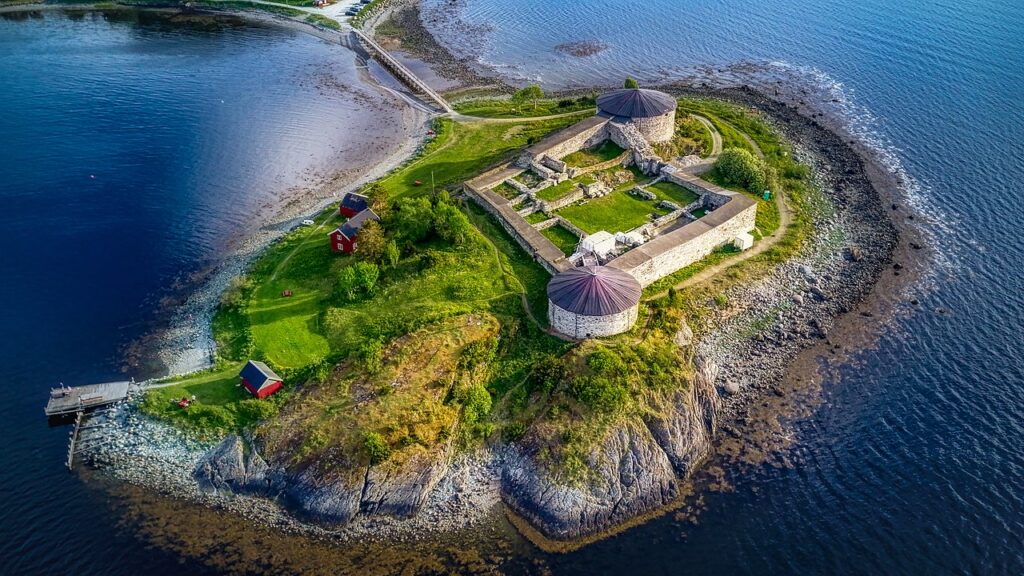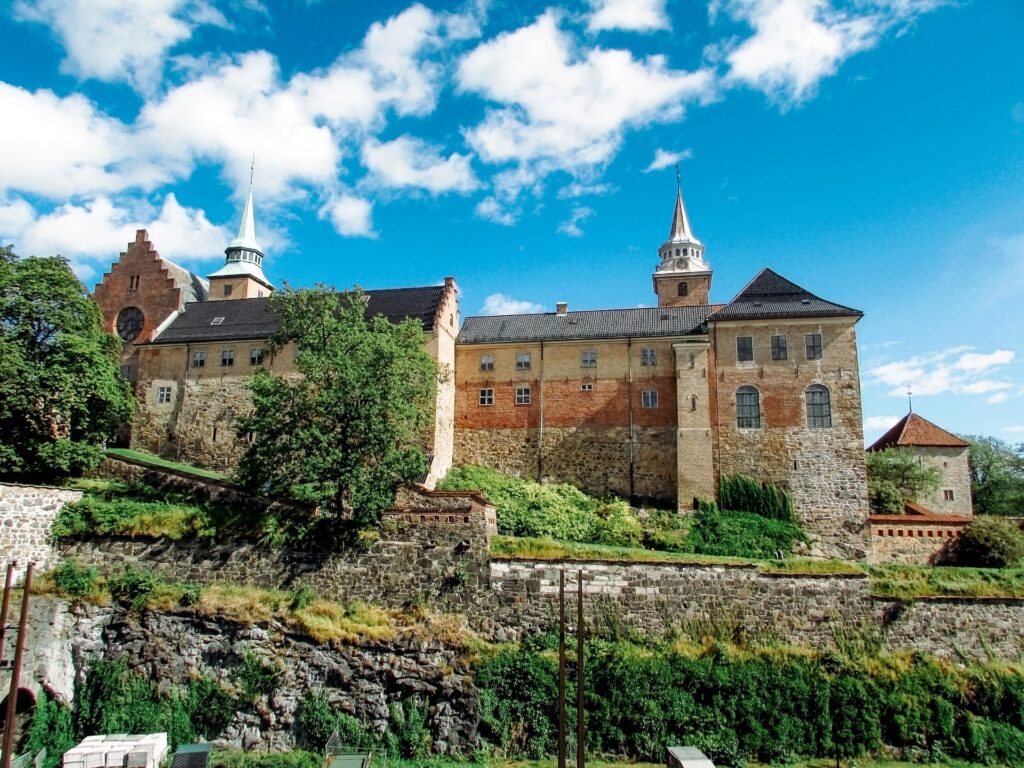Castles in Norway have played a significant role in the country’s history, serving as important cultural and political landmarks over the centuries. Moreover, as a country with a long history of royal dynasties and feudalism, Norway’s rulers strategically constructed castles to serve as defensive fortresses, royal residences, and symbols of their power and prestige.
These castles not only provided a fortified defense but also stood as magnificent structures, showcasing the rulers’ authority. Furthermore, with meticulous planning and construction, they became tangible representations of strength and grandeur, capturing the essence of Norway’s enduring heritage.
From Vikings to Palaces: The Evolution of Norwegian Castles
Norwegian castles hold immense historical significance, as they offer a captivating glimpse into the country’s vibrant past. The roots of Norway’s castle tradition can be traced back to the Viking Age, an era characterized by independent chiefdoms and a seafaring culture.
As the nation transitioned into the Middle Ages, the emergence of powerful dynasties and the spread of Christianity reshaped the landscape. Feudalism took hold, prompting Norwegian rulers to construct castles as potent symbols of their authority and defensive strongholds against external threats. Strategically positioned along coastlines and key trade routes, these fortifications safeguarded valuable resources and bolstered territorial control.
The evolution of Norwegian castles, from rudimentary fortresses to majestic palaces, mirrors the dynamic shifts in the country’s political and social fabric. Today, these castles stand as poignant reminders of Norway’s captivating history, paying tribute to the architectural brilliance and craftsmanship of the eras gone by.
The Grandeur of Norwegian Castles: Delving into the Eight Best
Akershus Fortress | Castles in Norway

Situated in Oslo, Akershus Fortress boasts a rich and captivating history that spans several centuries. Initially constructed in the late 13th century under the orders of King Håkon V, the fortress served as a fortified royal residence. Over time, Akershus Fortress underwent significant expansions and renovations, adapting to the changing military landscape.
For instance, during the 14th century, under the reign of King Haakon VI, extensive renovations were undertaken to enhance its defensive capabilities. Notably, additional fortifications were erected, bolstering the fortress against potential attacks.
Moreover, during the 17th century under King Christian IV, a grand reconstruction took place, embracing a Renaissance-style design. This transformation included the construction of bastions, ramparts, and casemates, which showcased the advancements in military architecture of the time.
But Akershus Fortress is more than just a monument frozen in time. It breathes life through its vibrant cultural events, where historical reenactments, theatrical performances, and concerts transport visitors to the days of yore. Immerse yourself in the lively atmosphere of a medieval market, where the aroma of spiced mead and the clang of blacksmiths’ hammers create an immersive experience that transcends time.
Visiting Akershus Fortress
Exploring the fortress’s labyrinthine passages and ancient chambers, you are enveloped in a sense of awe and wonder. Transitioning from one architectural marvel to another, you witness the seamless blend of medieval fortifications with Renaissance and Baroque influences. The transition from dimly lit corridors to sunlit courtyards is a reminder of the fortress’s dynamic past.
Ascending the towering battlements, a panoramic view unfolds before you. Transitioning from the serene Oslofjord to the vibrant cityscape, you grasp the strategic significance of this commanding stronghold. The transition from the tranquility within to the bustling city below is a vivid contrast, a reflection of the fortress’s historical role as a protector and observer of the capital.
Bergenhus Fortress | Castles in Norway

Bergenhus Fortress, an iconic stronghold located in Bergen, holds a captivating history that spans centuries. Founded in the 13th century by King Håkon Håkonsson, it emerged as a vital defense against external threats and a symbol of royal power.
Initially constructed as a royal residence, Bergenhus Fortress transitioned into a formidable military fortress. It withstood numerous sieges and battles, demonstrating its strategic importance. Over the years, the fortress underwent expansions and modifications, evolving into a complex architectural ensemble.
During the 16th century, Bergenhus Fortress witnessed a devastating fire that ravaged its structures. However, through meticulous restoration efforts, it was resurrected, transitioning into a grand Renaissance-style castle that reflected the era’s architectural trends.
Throughout its history, Bergenhus Fortress played an integral role in Norway’s political landscape. Transitioning from a royal residence to a strategic military stronghold, it hosted coronations, royal banquets, and diplomatic negotiations. Moreover, the fortress symbolized authority, passing from one ruler to another as power shifted hands.
Visiting Bergenhus Fortress
Once inside, a world of architectural marvels awaits, with magnificent structures revealing themselves at every turn. From the outer courtyards to the inner precincts, visitors are immersed in a rich tapestry of medieval beauty and historical significance. Notably, the impressive Håkon’s Hall and the iconic Rosenkrantz Tower command attention, each with its unique story to tell.
Moving through the fortress, a journey of discovery unfolds. Museums and exhibitions offer a deeper understanding of Bergen’s past, guiding visitors through a transition from ancient artifacts to interactive displays. Here, history comes alive, offering unique insights into the region’s rich cultural heritage.
Ascending the fortress walls, breathtaking vistas emerge, providing a transition from the fortress’s interior to sweeping panoramic views of the surrounding landscapes. From the vantage point atop the walls, visitors can marvel at the strategic positioning of this coastal stronghold, creating a stark contrast between the fortress’s storied past and the beauty of the Oslofjord.
Sverresborg | Castles in Norway

Sverresborg, situated in Trondheim, Norway, stands as an open-air museum showcasing the remnants of the historical Sverresborg Castle. King Sverre Sigurdsson constructed the castle in the 12th century, establishing it as a royal residence, military fortress, and cultural center.
Today, visitors can delve into the captivating ruins, experiencing a fascinating journey back in time. The site boasts reconstructed buildings and structures, offering insights into medieval Norwegian life.
Visiting Sverresborg
As you explore, you’ll discover the castle’s walls, towers, and gatehouses. Inside, engaging exhibitions provide glimpses into the daily lives of past inhabitants. Guided tours, historical reenactments, and hands-on activities enhance the educational and interactive experiences available.
With commanding views of Trondheim and the Trondheimsfjord, Sverresborg transports visitors to Norway’s medieval past, immersing them in its rich heritage. Furthermore, the museum offers valuable insights into the region’s history, culture, and the profound influence of Sverresborg Castle.
Steinvikholm Castle | Castles in Norway

Steinvikholm Castle, with its captivating history, takes us back to the late 16th century. Firstly, built as a royal residence under the visionary patronage of King Christian IV, this architectural gem became a reality. Furthermore, strategically situated on the island of Skatval, the castle offered a commanding view of the Trondheimsfjord.
Throughout its existence, it witnessed transitions of power and endured the turbulent times of the Nordic region. Despite facing sieges and fires, Steinvikholm Castle remains a testament to resilience.
Visiting Steinvikholm Castle
While some sections of the castle have been preserved and restored, other parts remain in a state of partial decay. The castle’s current condition showcases a mix of standing structures and crumbling remnants, giving visitors a sense of its historical significance and the passage of time.
The preserved sections allow visitors to envision the castle’s original layout and architectural features, such as its imposing towers and defensive walls. However, the ruins also highlight the castle’s turbulent past and the challenges of preserving ancient structures over the centuries.
Despite its partially ruined state, Steinvikholm Castle continues to captivate visitors with its historical ambiance and stunning location on the island in the Trondheimsfjord. It serves as a poignant reminder of Norway’s rich medieval heritage and the enduring allure of ancient castles.
Austråttborgen | Castles in Norway

Austråttborgen is a medieval manor house located in Ørland, Norway. It is known for its historical significance and impressive architecture. Built in the 17th century, Austråttborgen served as a residence for noble families, while it played a vital role in the local governance and administration during that time.
The castle exhibits a combination of Gothic and Renaissance architectural styles, both of which feature striking towers, ornate facades, and intricate details. Austråttborgen is surrounded by beautiful gardens and scenic landscapes, further enhancing its charm and allure. Today, the castle is open to the public and serves as a museum.
Visiting Austråttborgen
The main hall of Austråttborgen is a true marvel. It is adorned with intricate woodwork, ornate ceilings, and beautifully crafted furniture. Moreover, the hall exudes an air of elegance and sophistication, providing a glimpse into the lavish lifestyle of the noble families who once resided within its walls.
As you explore further, you may discover other rooms and chambers, each with its own distinctive character and historical significance. Additionally, the castle boasts a myriad of hidden treasures, from secret passages and grand libraries to opulent bedrooms and opulently decorated dining halls.
Moreover, paintings, sculptures, and tapestries adorn the walls, thereby adding to the visual allure of the castle. These artistic treasures offer a glimpse into the cultural and artistic sensibilities of the time.
Essential Tips for Visiting Castles in Norway
When embarking on a visit to the magnificent castles in Norway, there are several essential considerations to bear in mind:
- Firstly, be mindful of the castle’s opening hours to plan your visit accordingly. Additionally, considering joining a guided tour, as it provides valuable insights into the castle’s history, architecture, and notable features. Moreover, wearing comfortable shoes is crucial, given the extensive grounds and various levels to explore.
- Furthermore, it’s important to familiarize yourself with the castle’s photography policy, respecting any restrictions in certain areas or during specific exhibitions. Also, always adhere to posted signs and follow instructions from the staff to ensure a respectful and safe visit.
- To enrich your understanding, take the time to research the castle’s historical significance and context before your visit. This will enable you to appreciate the site’s cultural heritage to a greater extent. In addition, keep an eye out for any ongoing exhibitions or special events. They can often provide unique insights and memorable experiences.
- Be sure to take advantage of visitor facilities such as restrooms, cafes, and gift shops. Also, consider the weather conditions as some areas of the castle may be outdoors.
- Lastly, immerse yourself in the enchanting atmosphere! Embrace the opportunity to step back in time within the castle’s walls.
By keeping these considerations in mind, you’ll maximize your enjoyment and appreciation of the captivating Norwegian castles.
In conclusion, the castles of Norway beckon visitors with their enchanting allure. They provide a remarkable journey through time and a glimpse into the majestic past of this beautiful country.
All in all, most castles in Norway are certainly worth a visit. When planning your trip to Norway, be sure to include a visit to these captivating castles in your itinerary!
